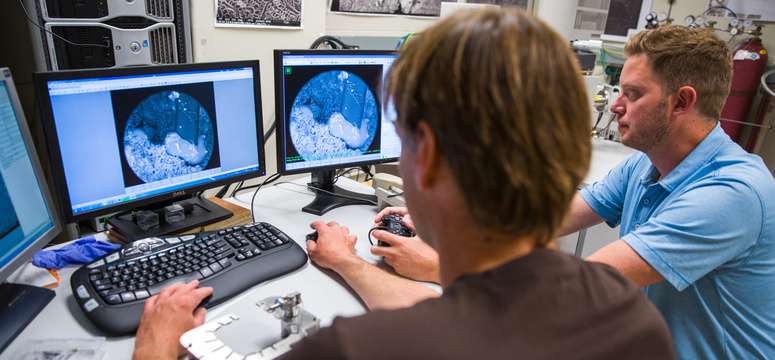The University of Calgary team studied three different methods to measure the wettability, or fluid-rock interaction, at the micro-scale in rock core samples from a producing tight oil formation in Saskatchewan. Credit: Riley Brandt, University of Calgary
University of Calgary geoscientists have developed new technology that measures, at an extremely fine scale, the interaction between water and other fluids and rock from an unconventional oil reservoir.
Faculty of Science researchers used their micro-injection system coupled with live imaging to precisely measure fluid-rock interaction, called "wettability," at the microscopic, or micro-scale, for the first time.
"We also showed that significant micro-scale variability in wettability occurs, as measured by the contact angles of oil and water micro-droplets with the rock's surface. This variability depends on the composition of the substrate (rock)," says Chris Clarkson, professor in the Department of Geoscience, and Alberta Innovates Technology Futures/Shell/Encana chair in unconventional gas and light oil research.
The research increases understanding of how wettability varies in oil reservoirs, which will help to optimize hydrocarbon recovery processes and could lead to new methods for extracting unconventional oil and gas. The team's study, "Live Imaging of Micro-Wettability Experiments Performed for Low-Permeability Oil Reservoirs," is published in Scientific Reports, a journal in the top-ranked Nature series.
Conventional method is imprecise
Understanding wettability is crucial for optimizing recovery of oil and natural gas, including in unconventional, or "tight," reservoirs where the rock's low permeability reduces the path where oil and gas can flow.
Recent advances in imaging enable the rock pore structures and compositions of tight reservoirs to be characterized at the sub-micron scale. This information is used in pore-scale models, to predict important reservoir properties such as permeability (the ability of rock to transmit fluid through pores and cracks).
However, companies still typically measure wettability at the much larger macro-scale (on the order of millimetres), using droplets of water, oil and other fluids placed onto a rock core's surface.
The problem is that the controls on wettability and how it varies occur with changes in rock composition at the micro-scale—down to individual mineral grains in the rock, Clarkson notes. So macro-scale measurements of wettability don't reflect these changes properly, "and can provide misleading results when combined with pore-scale modelling used to predict multi-phase fluid flow in these rocks," he says.
"Our aim is to create 'wettability maps' to quantify the change in wettability across the surface at the micron scale, and then populate the pore-scale models with this information."
Team studied different micro-wettability methods
The team studied three different methods to measure wettability at the micro-scale, in rock core samples from a producing tight oil formation in Saskatchewan. The first method involved imaging micro-droplets of distilled water condensed onto and evaporated from rock samples through a cooling and heating process. The second method imbibed water or oil onto samples—letting the rock soak up the fluids—and then cryogenically freezing the samples and making X-ray images of small pieces of the rock.
In the third and most innovative approach, the team micro-injected nano-litres of water at precise locations on the rock samples, controlling the fluids through a micro-capillary—a 'tube' smaller than a pinhead.
They captured live video images of all three methods using an environmental field emission scanning electron microscope (E-FESEM), located in UCalgary's Instrumentation Facility for Analytical Electron Microscopy. Clarkson says the time-lapse imaging "allowed us to identify the exact point to measure the proper contact angles between the fluids and the rock's surface."
The imaging also enabled the team to measure the rate of fluid imbibition into the rock. This is important in hydraulic fracturing of unconventional reservoirs to increase oil and gas recovery, for assessing the impact injected fluids have on altering reservoir properties.
Next step: designer fluids to improve recovery
All four team members are co-authors on the study. Clarkson came up with the idea of using the E-FESEM to perform systematic studies of micro-wettability. Hanford Deglint, a PhD student of Clarkson's, developed an innovative method to extract and calculate the contact angles in the micro-wettability experiments and aided in experimental design. He and geoscience technologist Chris DeBuhr set up and ran the experiments. Amin Ghanizadeh, a geoscience research associate, performed macro-wettability measurements on samples to compare them with the micro-wettability results.
The team's next step, in a separate project funded by the Canada First Excellence Fund, is to collaborate with UCalgary colleagues on designing fluids containing, for example, nanoparticles or polymers that could change the micro-wettability of reservoir rocks.
"This will allow us to tailor fluids to the type of rock that we have, to manipulate wettability and improve recovery of tight oil and gas," Clarkson says.
More information: Hanford J. Deglint et al. Live Imaging of Micro-Wettability Experiments Performed for Low-Permeability Oil Reservoirs, Scientific Reports (2017). DOI: 10.1038/s41598-017-04239-x
Journal information: Scientific Reports , Nature
Provided by University of Calgary
























